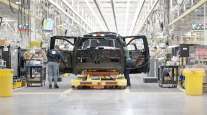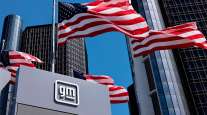Ford Boosts Output of Big SUVs for Second Time in Two Years

Ford Motor Co. is boosting production of its biggest, highly lucrative sport utility vehicles for the second time in two years at a U.S. factory already bursting at the seams.
The automaker is increasing Ford Expedition and Lincoln Navigator output by 20% — about 20,000 additional SUVs a year — by speeding up the assembly line and redesigning it so multiple workers can manufacture the SUVs simultaneously. Ford executives declined to say how much they’re spending, but an upgrade of the same Kentucky plant announced in February 2018 cost $25 million and followed a $900 million investment the year before.
The hot-selling SUVs are critical to Ford’s future because they generate profit per vehicle that analysts say can exceed $20,000. That helps finance the billions Ford is pouring into electric and self-driving vehicles that are considered the cars of tomorrow. While Ford won’t be adding factory jobs, it’s picked a fortuitous time to tout the expansion, with rival General Motors Co. drawing fresh ire from President Donald Trump for closing factories.

Loncoln Navigator (Mark Kauzlarich/Bloomberg News)
“This is one of our highest-volume plants in the world,” John Savona, Ford’s vice president of North American manufacturing, told reporters at the company’s headquarters in Dearborn, Mich. Ford “needed to figure out how to increase production in a plant that was already operating at top speed.”
Navigator sales soared 70% last year, thanks to a bossy redesign, while Expedition sales rose 5.4% according to researcher Autodata Corp. Retail deliveries of Expedition, revamped for the first time since 2003, jumped 35%, according to Ford. Perhaps most importantly, the average selling price of an Expedition climbed about $11,700 to $62,700.
Ford lacks the space to knock down walls and expand the factory, so it’s digging pits along the assembly line for workers to attach components such as running boards from below, while other workers above install interior parts. The company also is speeding up the line so it can crank out more than 60 SUVs an hour, Savona said.
Ford will make the changes in July while the plant is on summer shutdown for two weeks.
“We had to go up and down because we didn’t have space to actually do brick and mortar to put another line in,” Savona said. “We had to really get creative.”

Ford plant in Louisville, Ky. (Luke Sharrett/Bloomberg News)
Ford also will add 550 workers to the Kentucky factory, but they’ll come from the automaker’s neighboring Louisville plant, which makes the small Escape SUV.
The automaker is rolling out a redesigned Escape this year aimed at reversing the sales slide of its aging model. Savona declined to say if Ford eventually will need to replace the workers Louisville is losing to support the Expedition and Navigator.
With Trump assailing GM on Twitter for three days straight over ceasing production at a car factory in Ohio, Savona made a point to say Ford is “committed to manufacturing in the United States, as we have for more than 100 years.”
But as part of an $11 billion restructuring, Ford has begun dismissing salaried employees, and a Morgan Stanley analyst has predicted the cuts could reach 25,000 worldwide. Net income fell by more than half last year, as the company lost money in every regional market except North America, where it has become increasingly dependent on big F-Series trucks and SUVs.




